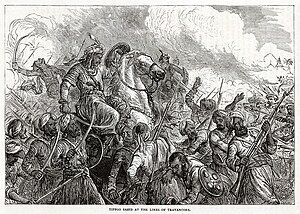Battle of the Nedumkotta
| Battle of Nedumkotta | |||||||
|---|---|---|---|---|---|---|---|
| Part of the Third Anglo-Mysore War | |||||||
| Sketch of Tipu Sultan's advance on the lines of Travancore, by James Grant (c 1896). | |||||||
|
|||||||
| Belligerents | |||||||
|
|
|
||||||
| Commanders and leaders | |||||||
|
Dharma Raja Raman Kesavan Pillai V. Padmanabha Pillai |
Tipu Sultan Ali Raja Bibi Junumabe II |
||||||
| Strength | |||||||
| unknown | 35000 infantry and cavalry | ||||||
Mysorean advances into Travancore, Tactical British and Travancore victory.
The Battle of the Nedumkotta took place on 28 December 1789, and was a reason for the opening of hostilities in the Third Anglo-Mysore War. Forces of Tipu Sultan, the ruler of the Kingdom of Mysore, attacked the fortified line known as the Nedumkotta in Thrissur district that protected the Kingdom of Travancore, an ally of the British East India Company. Tipu Sultan made major advancements on Travancore, however, had to return to his Kingdom to prepare for a British attack.
The strength of the Travancore Nair Army was greatly reduced after several earlier battles. As the threat of an invasion by Tipu Sultan loomed in the horizon, Travancore's maharajah later to be called Dharma Raja tried to rebuild his army by appointing Chempakaraman Pillai as the dalawa and Kesava Pillai as the sarvadhikaryakkar.
Tipu Sultan planned the invasion of Travancore for many years, and he was especially concerned with the Nedumkotta fortifications, which had prevented his father Hyder Ali from annexing the kingdom. Towards the end of 1789, Tipu Sultan marched his troops from Coimbatore. Tipu's army consisted of 20,000 infantry, 10,000 spearmen and match-lockmen, 5,000 cavalry and 20 field guns.
Travancore purchased the strategic forts of Cranganore and Ayacottah from the Dutch to improve the country's defenses. The deal was finalized by Dewan Kesava Pillai and Dutch merchants David Rabbi and Ephraim Cohen under the observation of Maharajah Dharma Raja and Dutch East India Company Governor John Gerard van Anglebeck. Travancore also held a treaty with the British East India Company, under whose terms two battalions of the Company army were stationed at the Travancore-Cochin frontier. Tipu Sultan objected to these purchases because the forts, even though they had long been in Dutch hands, were in a territory that paid him tribute.
...
Wikipedia

